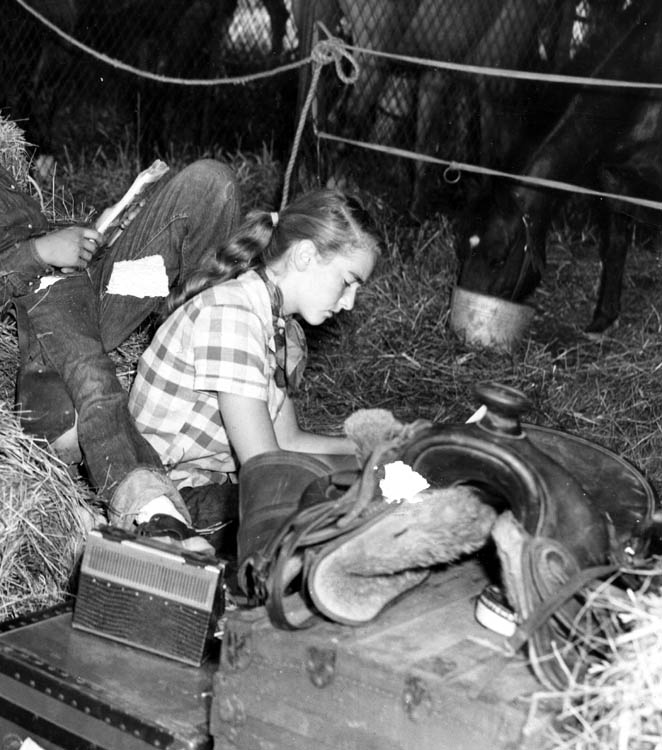Costume History assignment, Apparel Design Program
April 2010
In 1945 my grandfather purchased an abandoned country club with 132 acres that had gone broke during the depression. He became what they called a “gentleman farmer,” commuting 30 miles to Detroit to work during the week, and spending weekends planting trees and multi-flora rose barriers. Mom was 5.
“When you lived in the country people would give you animals,” said my mom. This applied to the dogs, livestock, and horses that would come and go. Over the years there was a retired polo horse, a draft horse Dukie, a quarter horse, a pony Patsy and her colt, and mom’s colt Bucky. At age 10, and miles from the nearest neighbor, mom had no friends, and was completely isolated in the country. After school she’d go home, eat ice cream, and then ride Bucky or Patsy around all afternoon. She wasn’t strong enough to put the saddle on herself. It was old fashioned with no buckle, and given to the family for free, like the horses. So she just rode bareback.

By the time she was 12, she had joined the horse section of the 4-H club and made some friends. Her 4H friends rode English, but she rode Western. If she cut through the fields she could ride to their houses in daylight, then turn immediately around, and come back home in the dark. For her first 4H event she knew she couldn’t wear her saddle shoes. So on a family car trip out west she got some red cowboy boots from Miller Stockman in Denver. Later she got a red western shirt to match the boots.


On Fridays, from the age of nine, mom stayed in town after school. She would entertain herself until her parents would retrieve her, around 11pm. She had $1 in her pocket. The afternoon was spent roller skating (something she couldn’t do in the country since there were no paved roads). Then a 50¢ dinner at the seedy hotel: cheese burger, french fries and a coke. A double feature movie was 25¢. It was the golden age of Hollywood Westerns and mom watched cowboy movies like Roy Rogers and Gene Autry. Roy’s wife, Dale Evans, was every girl’s idealized cowgirl. She wore a suede fringe skirt, and mom wanted one. Her mother ordered her one from the Miller Stockman catalogue but it didn’t fit, and she never wore it.
Many of our family photos portray my mom as a classic 1950s teenager. Her everyday school outfit — saddle shoes, bobby socks, a straight wool skirt with slits, and a sweater. Her prom dresses, either store-bought, or made in the current styles by the local seamstress. But it is the images of her under the big sky, riding bareback in cowboy clothing, with her dog at her side, that capture some essence our family’s western heritage.


Her own father was born in 1900 in a sod house on a ranch in Kansas. He rode in rodeos to make money during college, though was too small for anything but bronco busting. Her aunts were girls raised in the west who “felt fewer social constraints than their mothers.” (Smith 73). They told how they rode astride on the prairie, that is, until they saw a boy coming: then they’d go sidesaddle.

Mom’s 1950s riding outfit: boy’s jeans, cowboy boots, a western shirt, and a scarf, was very little changed from that worn 70 years earlier by the first cowgirls. They wore the clothes of a man — trousers, wide brimmed hats, bandannas and boots, all to provide comfort during the long hours in the saddle.
Many years later, after my mom had grown, moved from the country, and graduated from college she still held onto her beloved red cowboy boots.

Bibliography
Kallen, Stuart. A Cultural History of the United States Through the Decades The 1950s . San Diego: Lucent Books, 1999. Print.
Smith, Catherine, and Cynthia Greig. Women in Pants: Manly Maidens, Cowgirls, and Other Renegades . New York: H.N. Abrams, 2003. Print.